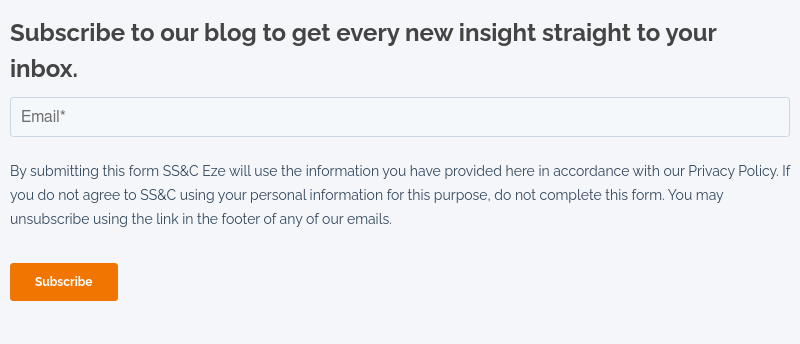It has been one year since the SEC announced its decision to shorten the standard settlement cycle for most broker-dealer transactions in securities from two business days after the trade date (T+2) to one (T+1).
As we wrote last year, the shorter settlement cycle is a positive development for the securities markets, helping to make them more efficient while reducing the risk of settlement failures.
Other benefits include:
- Wider adoption of straight-through-processing (STP)
- Reduction of margin required
- Mitigation of operational and systemic risk
- Reduction in costs and resources associated with unsettled positions
Since the announcement, in addition to working with SS&C clients who, like other buy-side investment firms, are preparing for the upcoming change, I’ve spoken with prime brokers, broker-dealers, fintech firms, and other industry players to learn what their experiences ahead of the transition have been like.
In this post, I share some of my findings and make recommendations as to how firms can ready themselves for the move to T+1.

Lessons Learned on the Path to T+1
Increased Importance of Automation
When we wrote last year about steps the buy-side could take to prepare for T+1, we recommended firms consider automating any manual pre- and post-trade processes that could delay T+1 settlement.
In working with clients since then, I’ve seen firsthand the impact automation will have on firms, brokers, and their staffs.
Under T+2, buy-side operations staff or brokers could manually fix any breaks in trade processing the day after the trade was made. But with the upcoming shortened settlement cycle, allocation and confirmation must happen on the trade date, making the new affirmation deadline 9:00 PM ET.
Because neither staff nor brokers want to manually fix breaks in the evenings, I increasingly see executing brokers encouraging buy-side firms to adopt post-trade technology that moves them closer to straight-through processing (STP).
Other Recommendations for Preparing for T+1
The transition to T+1 is fast approaching. Canada and Mexico will move to T+1 on Monday, May 27, 2024, and the United States will follow suit on Tuesday, May 28, 2024 (due to the Memorial Day holiday).
For a smooth transition, in addition to automating manual trade processes, firms should consider:
- Communicating with counterparties: T+1 compliance will require close alignment with counterparties. Preparatory discussions should cover any changes to trade delivery timing and emphasize the need to communicate corrections or changes to trade allocations in real-time rather than EOD.
- Reviewing compliance-related processes: The shortened settlement cycle may require updates to compliance-related procedures to ensure all the necessary approvals are in place promptly.
- Revisiting lending practices: The move to T+1 settlement may also impact firms' security lending practices. Firms should review their contract terms to align with the new settlement cycle.
Disparity in Expected Costs to Accommodate T+1
A more surprising finding from working to prepare clients over the past year has been lower-than-expected staffing costs related to T+1.
With the announcement of the move to T+1, some firms braced for an increase in costs required to add staff to settlement, operations, and technology functions.
However, as firms have transitioned their operations to accommodate the new settlement cycle, many have been pleased to find that with automation and the outsourcing options available to them today, the necessary staffing costs are not what they once feared.
At SS&C, many clients are choosing to leverage Eze post-trade Managed Services to aid in this transition without adding internal headcount. Outsourcing to these experienced teams is often more efficient and conserves clients’ existing internal resources for higher-value work.
Open Road Ahead: SS&C is Ready for T+1
SS&C has been working diligently to support Eze clients’ moves to T+1 while adhering to Depository Trust & Clearing Corporation (DTCC) best practices. Current measures include:
- Automation to expedite allocation and trade finalization
- Automated release of trades to third parties and matching tools
- Eze Managed Operations for pre-trade and post-trade functionality
- Electronic matching and allocation delivery with the executing broker
- Ability to automate manual trade delivery instructions to various market participants
- 24-hour service team coverage offering foreign clients investing in US markets local support when needed
- Daily fails reporting notifying investment managers of trade failures
If you have questions or need more details on T+1, contact your client success manager or reach out to learn more.


